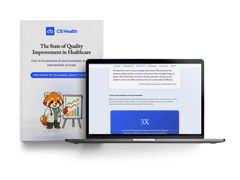
3 Tips on How to Train Healthcare Employees 2024
In healthcare, continuous learning is essential. That's because, with new discoveries and treatments, technologies, and guidelines emerging, those providing care need to stay updated on the latest knowledge.
While today's healthcare training often involves old-school lectures and drills, it's clear one-size-fits-all methods don't work. There's a need to offer tailored education to a diverse workforce. Let's take a look at three essential tips that'll help you offer more effective training in your healthcare organization.
Meet the Expert
Mical DeBrow is an accomplished healthcare leader and clinician with extensive expertise spanning pharma, healthcare payers and providers, and healthcare information technology.
» Looking to consolidate all your healthcare knowledge in one system? Check out C8 Health's features.
3 Tips on How to Train Healthcare Employees
1. Know Your Learners First
Start by taking the time to understand each providers’s current skill level. This will help you build on what they already know.. This is an important step since new hires often face a critical gap in knowledge.
Design your training content and formats to match their work experiences, education, expertise, and comfort with tech. Don’t make assumptions about what they need or want. Get to know your team and what drives them. Use interviews or surveys to find out their strengths, areas for growth, and the best ways for them to learn.
The traditional classroom approach may lose around 50 percent or more of your audience. We must be smarter in assessing learners by recognizing their diverse knowledge levels and understanding that adult learners have different preferences.
For example, a well-designed training program should incorporate multiple teaching methods to accommodate the diverse requirements of learners. Experienced nurses with busy schedules may prefer online modules, while new assistants may require in-person coaching to understand their roles better.
2. Embrace Technology, But Don't Force It
Embrace modern training tools like personalized mobile access, virtual simulations, online modules, and instructional videos. These technologies offer engaging ways to deliver content during onboarding and beyond.
Not everyone is comfortable with virtual methods. So, while we promote these technologies, we also understand the diverse preferences within our team. Some might prefer traditional methods but appreciate the flexibility that technology brings.
While it's absolutely key to introduce AI and technology innovation in healthcare, it's equally important to offer choices that align with different learning styles. When we bring in new technology, we make sure to provide easy-to-follow guides and resources for troubleshooting.
For example, a nurse might want to use virtual reality for training on new equipment, but also appreciate in-person guidance the first time. This balance can offer reassurance, especially when dealing with new equipment, and can help reduce potential errors.
By accommodating diverse preferences and offering a mix of traditional and tech-based methods, we can create a more effective and inclusive training environment.
Tools like knowledge management platforms can make training easier and more collaborative. Download our latest report to learn more.
3. Patience Is Key
When it comes to picking up new skills, healthcare organizations need to be patient with their staff. Mastering complex medical procedures and protocols takes time and hands-on practice.
During my experience teaching advanced cardiac life support classes, I found that skill stations were far more effective than lectures alone. The ability to repeatedly practice life-saving techniques on models provided a real-world experience that lectures could not replicate.
Practice is important, so to avoid staff burnout, organizations should set fair timelines for learning new skills. Simpler skills might take a few weeks to learn, while more complex ones could take months.
During this learning journey, staff need ongoing support and a bit of cheerleading from management. With patience and solid hands-on training, staff can slowly but surely become proficient.
The end result? Skilled medical professionals who can give top-quality care and become valuable members of their hospitals and clinics.
» Explore the types of health information technology and their uses.
Overcome Training Challenges
Switching to a more tailored, personalized training methodology presents some challenges. But there are ways that healthcare teams can work around these obstacles to implement healthcare training effectively.
- Limited budgets: Efficiently allocate resources for curriculum development and training staff. Build a business case showing the benefits of better engagement and outcomes.
- Trainer inexperience: Some clinical experts may not be formally trained in adult education methods. Therefore, it is crucial to invest in developing great training skills to increase adherence to best practices in healthcare.
- Change resistance: Employees accustomed to traditional training may resist new formats. Promote the benefits of personalized learning through coaching, incentives, and role modeling by managers.
» Here's how C8 Health can make life easier for your medical team.
Empowering Healthcare with Tailored Education
Good clinicians should stay patient-focused. For healthcare training in 2024 and beyond, we need to replace outdated methods with more personalized, flexible, and fresh ways to enhance operational efficiency.
A smarter approach involves allocating more budget for education and exploring diverse methods of knowledge transfer. Some may learn from articles, others from a classroom or hands-on demonstration.
While investing in various tools like C8 Health might increase costs, the payoff is invaluable: improved patient outcomes.
Organizations that invest in truly personalized training, using technology like C8Health to accelerate the adoption of new skills and reduce repetitive standardized instruction, stand to gain immensely.
Such organizations will have skilled, motivated employees, ready to deliver top-tier patient care now and into the future.
» Here is the pivotal role AI plays in maximizing efficiency in modern healthcare


